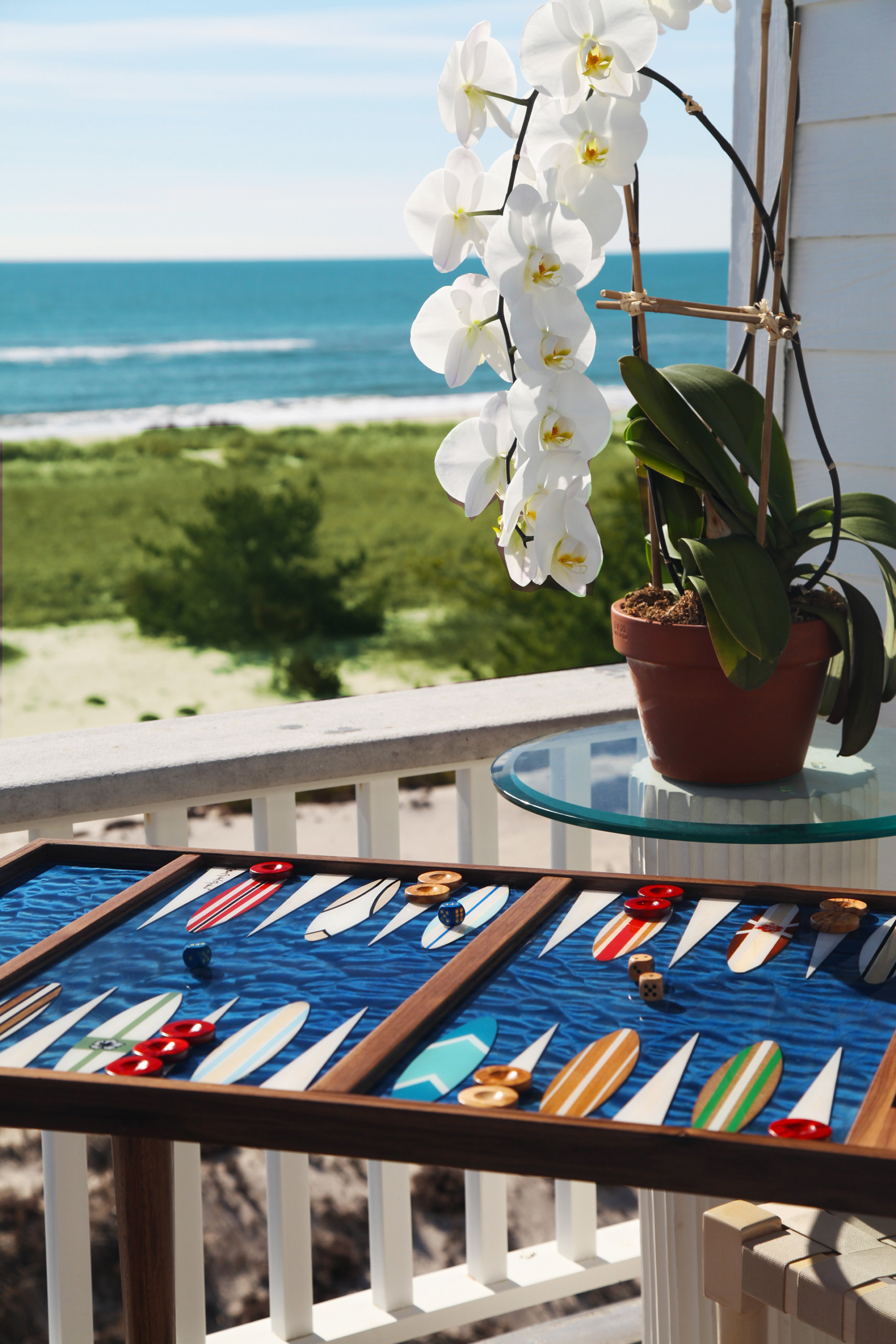The Art Of Backgammon


Westhampton Beach woodworking artisan Jean-Michel Andriot creates one-of-a-kind backgammon boards and tables that reflect nature and the sea.
How did you first become passionate about backgammon?
My interest in backgammon is mostly in the design and construction of the game, and that’s what inspired me to start thinking of making these nicely crafted art pieces using my woodworking skills as a foundation. I know this is surprising, but I don’t play backgammon — yet. I think my lack of knowing the game as a player is what freed me up to break its visual and structural rules, in a way.
How did you start in woodworking? Do you create other pieces besides backgammon boards?
I have a lot of European craftsmanship in my heritage, from my grandfather who was a cabinet-maker and upholsterer in Paris to my architect dad who was always building and creating something — though I wasn’t a woodworker by trade when I lived in France.
When I moved to the United States 15 years ago, the French community was the most natural connection point for a transplant like me; so, I started working with French restaurateurs in Manhattan creating custom furniture for them and refurbishing pieces, and I continued that when I came to the Hamptons.
I was always doing furniture “reinvention” — I’d take a piece that was fairly outdated or unloved, and I’d create something totally fresh with it. I guess now that I think about it, the premise of twisting the traditional has always been in my blood.
How did you decide to hone your skill and start creating boards?
It really wasn’t an intentional decision. I had wondered, after seeing friends play the game, about messing around with the format — part of my non-conformist side, I guess. At the time, I was making some home décor pieces, like serving trays, small tables, with different woods, pewter, and hand-patinaed copper. I was just experimenting, and made the first board with beautiful woods, and a pewter inlay square in the middle — which has no purpose in the game, but it was my way of seeing how the two work together — and I made points in a teardrop shape, and then had the points “floating” above the board rather than inlaid. And it all came together and looked quite nice.
And when that one got a good reception, I just kept creating different designs — and realized that making them brought together my artistic side with my technical woodworking side, and that was key to helping me make things that people appreciate. I enjoy making them very much.
You use nautical and ocean themes, and have lived on the water most of your life. Have you had commissions with particular themes?
Well, the themes of the boards I create vary; one of my most popular is the surfboard theme. I’ve had clients send me photos of their personal surfboard or paddleboards, and I’ve replicated them on the board, which makes the piece really special to the owner.
I was also asked to design a piece for a resort outside of Las Vegas, so I subtly incorporated playing card symbols — clubs, diamonds, hearts — on the points, in gold leaf. So, it kind of was a nod to one game, while playing another, and the gold was a nod to the opulent aesthetic out there. I like incorporating that kind of little twist and wink.
Another client wanted a board for their home in Hawaii, so we used beautiful Hawaiian Koa wood, and also made the surfboards more like Hawaiian surfboards.
How long does it take to make one of your boards?
Well, I don’t measure it in terms of hours, because it’s not a continual, linear process. But the whole creation takes about three-to-four weeks, more or less, depending on the project. I do nearly everything by my own hand. I want to be in full control of the product, and I need to design it, source the wood (some of the more exotic pieces I use aren’t found locally), cut, create, construct, finish, and myriad other steps that take up the several weeks of creation time. But in the end, my clients say they don’t care about waiting a few weeks for something that they wind up enjoying so much.
Are you thinking of creating other boards, like for chess?
I definitely have some ideas for chessboards. I’ve gotten a few requests for them; one blends woods and metal. I just need a little time — probably in the slower winter months — so hopefully I’ll have something to show by next spring!
How did you come to the Hamptons? What do you like to do when you’re not working?
When I first came to the U.S. from the South of France, living in Manhattan, I really didn’t fit in with an urban lifestyle at all. I’d often visit out here with my wife, visited her friends and mine, and even did some furniture work out here for friends and clients.
And I fell in love with the East End because it was the closest thing around here to the natural beauty and calm and seaside I grew up with. So eventually (around five years ago), we made it a more or less full-time home. And like with many folks, being here really inspired me in so many ways and brought out my creativity.
And, to my happy surprise, there are plenty of French out here as well, so I like to gather with them when I can, and, you know, do what we French love to do — drink good wine, eat good cheese and foie gras, and have long meals with great conversation — c’est parfait!
Those interested in Andriot’s creations can view more at www.studiojeanmichel.com.
bridget@indyeastend.com



